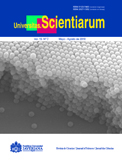Abstract
Objective. To establish if there is any relationship between the type and amount of dietary carbohydrates commonly consumed and the plasmatic levels of lipids, lipoproteins and apolipoprotein B100 (ApoB100). Materials and methods. The final sample was conformed by the database of 144 lecturers of the Pontificia Universidad Javeriana who had previously participated in another survey and from which we used information on their food habits, plasmatic lipid levels, lipoproteins and ApoB100. To determine the relationship between the dependent and independent variables, simple and multiple correlation analyses were done. In the cases of no correlation we applied the independence Chi2 test to find the relationship with the consumption of total carbohydrates, sugars and total fiber. Additionally, with a one-factor analysis of variance we compared plasmatic levels of lipids, lipoproteins and ApoB100 with the consumption of total carbohydrates, sugars and fiber. Results. Most of the population consumes above the daily total carbohydrate recommendation, men presented greater carbohydrate consumption of the type of sugars and more elevated plasmatic levels of triglycerides and lipoproteins of very low density (VLDL), whereas women presented higher levels of their high density lipoproteins (HDL). When relating grams of each type of carbohydrates with the levels of lipids, lipoproteins and ApoB100, no significant correlation was found for any of the cases (p>0,05). Conclusion. There was no significant relationship between the type and amount of carbohydrates consumed with the plasmatic levels of lipids, lipoproteins and Apo B100.
Key words: apolipoprotein B100, carbohydrates, plasmatic lipids, lipoproteins.
Univ. Sci. is registered under a Creative Commons Attribution 4.0 International Public License. Thus, this work may be reproduced, distributed, and publicly shared in digital format, as long as the names of the authors and Pontificia Universidad Javeriana are acknowledged. Others are allowed to quote, adapt, transform, auto-archive, republish, and create based on this material, for any purpose (even commercial ones), provided the authorship is duly acknowledged, a link to the original work is provided, and it is specified if changes have been made. Pontificia Universidad Javeriana does not hold the rights of published works and the authors are solely responsible for the contents of their works; they keep the moral, intellectual, privacy, and publicity rights. Approving the intervention of the work (review, copy-editing, translation, layout) and the following outreach, are granted through an use license and not through an assignment of rights. This means the journal and Pontificia Universidad Javeriana cannot be held responsible for any ethical malpractice by the authors. As a consequence of the protection granted by the use license, the journal is not required to publish recantations or modify information already published, unless the errata stems from the editorial management process. Publishing contents in this journal does not generate royalties for contributors.



